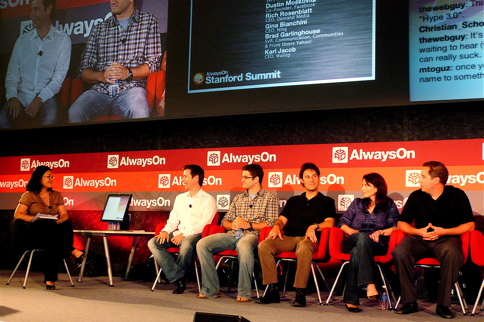Social networks: what goes out, what goes in

"Social Networking 3.0" was on the agenda this afternoon at the AlwaysOn Stanford Summit. This one was a "must watch" for me, as will be Dan Farber's later today on "The Democratization of Media." You can follow along with the conference's live Webcast here.
Moderator Charlene Li, senior analyst for Forrester Research, was joined by Travis Katz, senior vice president and general manager of MySpace International; Dustin Moskovitz, co-founder of Facebook; Rich Rosenblatt, CEO of Demand Media and former MySpace executive; Gina Bianchini, CEO of Ning; and Karl Jacob, CEO of Wallop. Dan blogged the panel on Between the Lines, and, as he says, most of the discussion focused the future of social networks. I was most interested in the comments concerning social networks and identity, attention, and intellectual property.
Travis Katz, Dustin Moskovitz, Rich Rosenblatt, Gina Bianchini, Karl Jacob
On the attention front, in response to the question "Where's the money going to come from?" the panelists answered with nearly a single voice: targeted advertising. But transactions based on user desires and intentions are on the radar as well:
Travis Katz: the advertising model on social networks is going to be here a long time. Other models will probably emerge too. MySpace is looking at ecommerce models. You always feel better buying from a trusted source. When you talk about transactions between individuals, there's a commerce opportunity there too.
Karl Jacob: Wallop is all transaction, no advertising. We believe there's a world down the road where you buy the things you need to dress up your profile and the applications you want to use. Akin to the ringtone market.
Gina Bianchini: If I had to choose between the ringtone market and targeted advertising, I'd choose targeted advertising. There's a huge opportunity to bring what is happening with AdWords into social networks. If you take a monetization model that's working today and generating significant amounts of money, and apply it to a market that is only going to get bigger and more sophisticated as far as targeted advertising, it gets very interesting.
Finally, on the subject of intellectual property, when asked what was missing from the social networking ecosystem and what he would invest in if given the opportunity, Rich Rosenblatt commented on the need for what I would call a "third estate" of media: outside the copyright and use limitations of the products of the big studios, labels, and publishing houses, and yet a step above one person's photos, films, etc. made primarily for personal use. A class of media produced and designed for Web distribution. Gina Bianchini challenged the notion that "amateur" media can't comprise this third estate:
Rich Rosenblatt: We'd like to see more content actually made for the Internet. There are two layers of content. Studio generated (lots of trouble and fighting there), and user generated but not usable (one guy's photos of himself). We'd like to see content that more than a few people want to see.
Gina Bianchini: I would argue that that's happening today. On YouTube some of that gets lost in the crowd, but put it in a community of really interested people, and it's very powerful.
Rich Rosenblatt, to Gina: But if you could buy wakeboarding content for your wakeboarding social network, wouldn't that be great?
Gina Bianchini: From my perspective, one of the benefits of social networks is you and your friends can watch your own stuff. Another benefit is the good stuff rises to the top. I would rather have the material be truly user generated.
Karl Wallop: the good content and the good applications will all come from the current and up and coming generations of users.
I have long thought Creative Commons moves us significantly closer to this third estate media ecosystem, but doesn't quite take us all the way there. John Palfrey points this out in his post today on blog scraping and the ongoing licensing/compensation gap.
